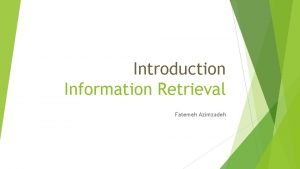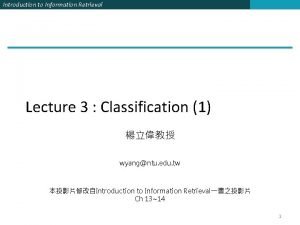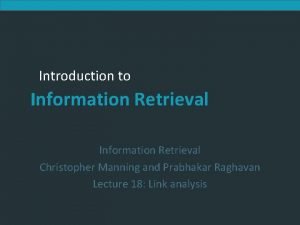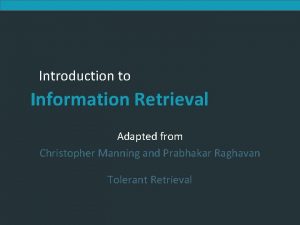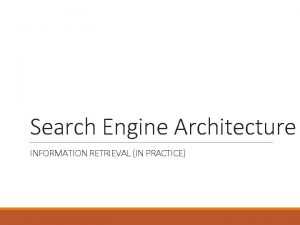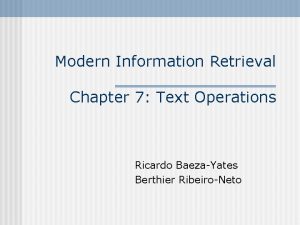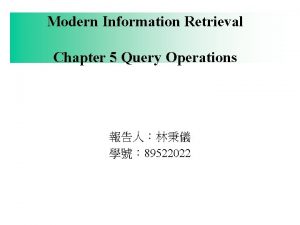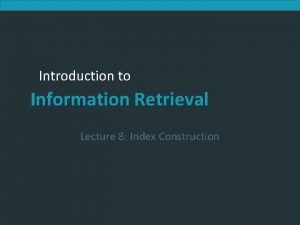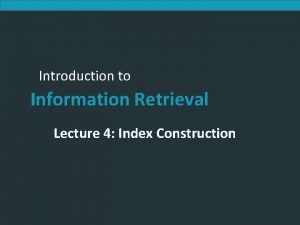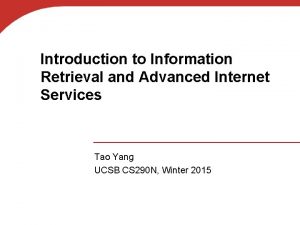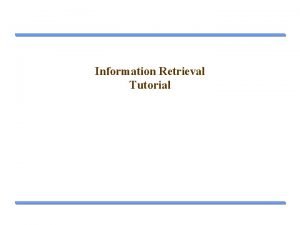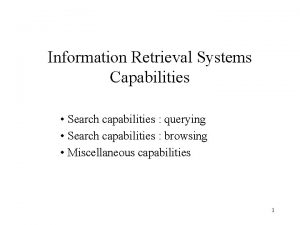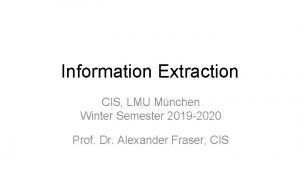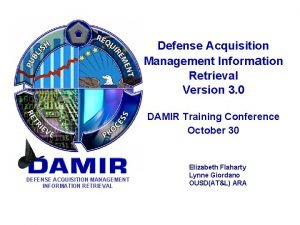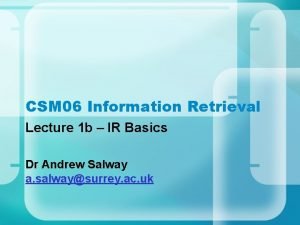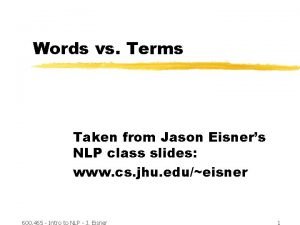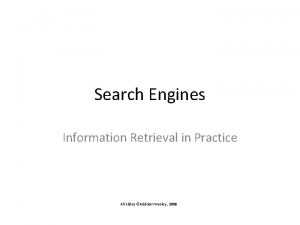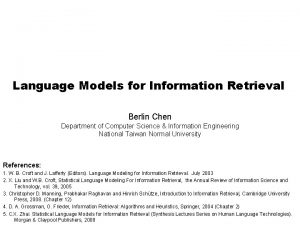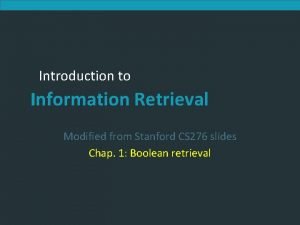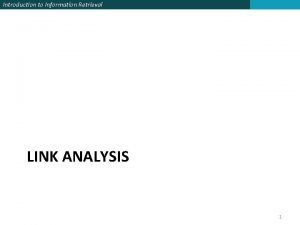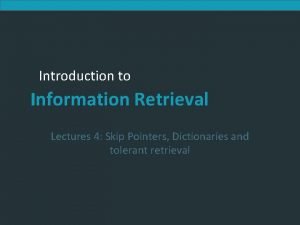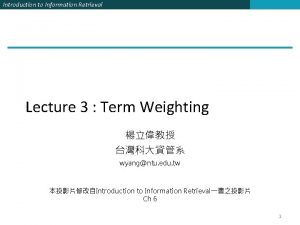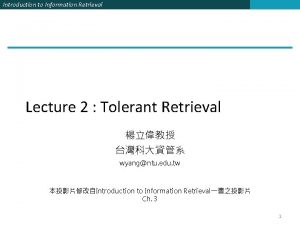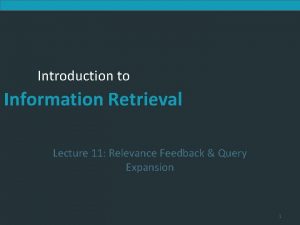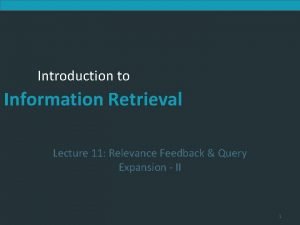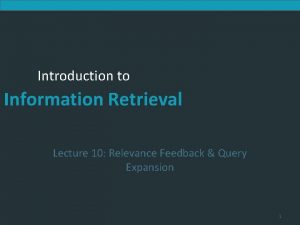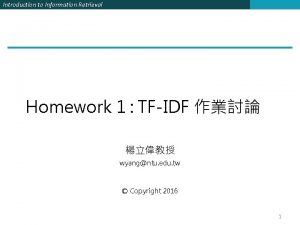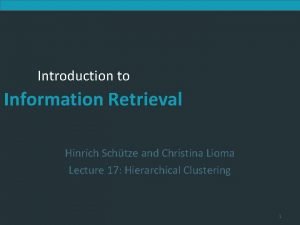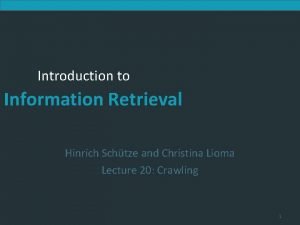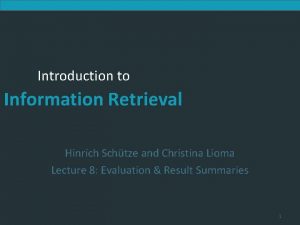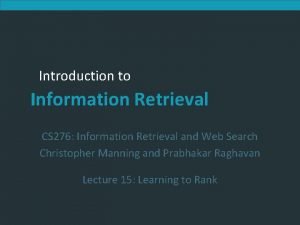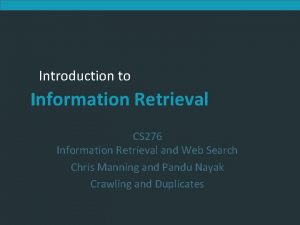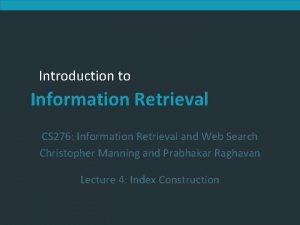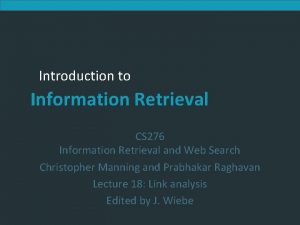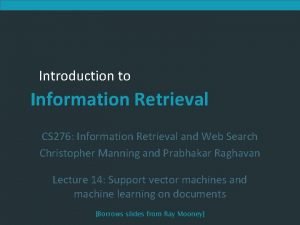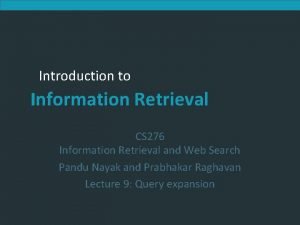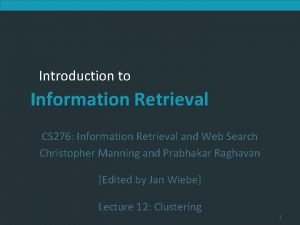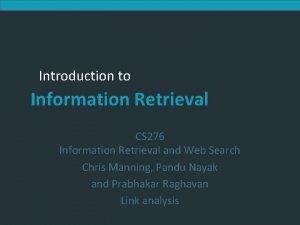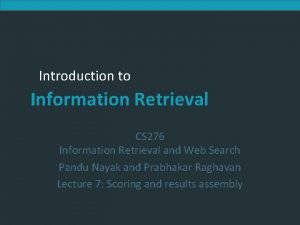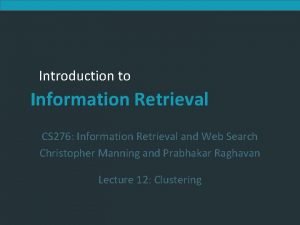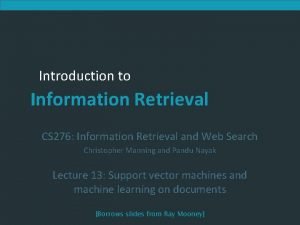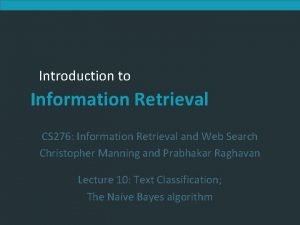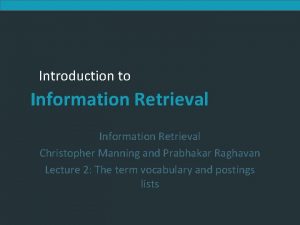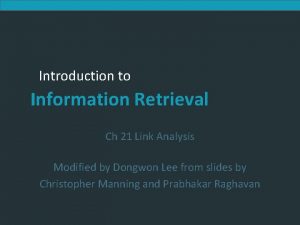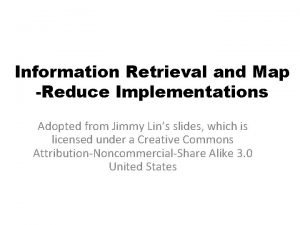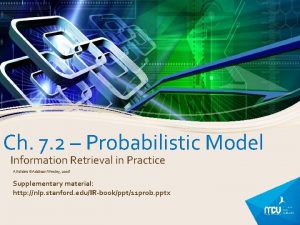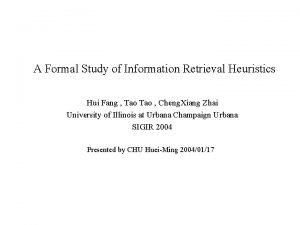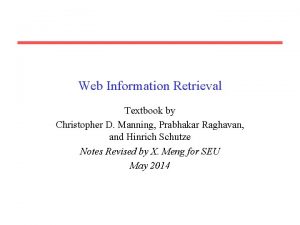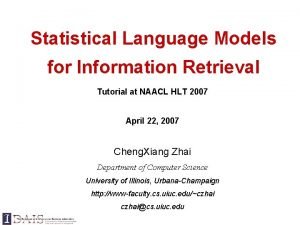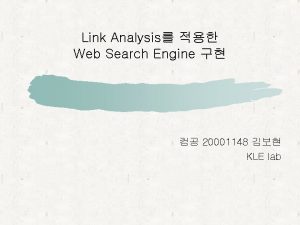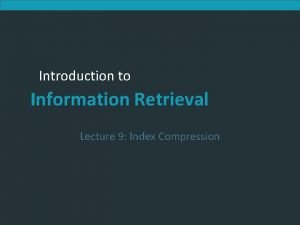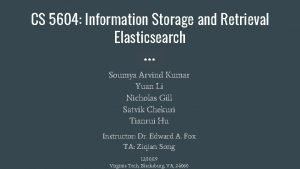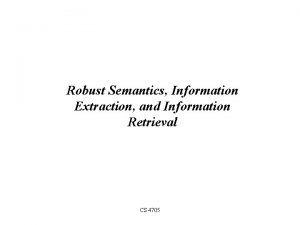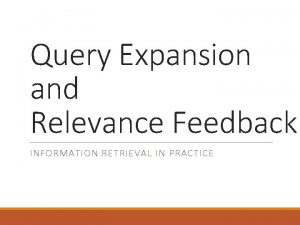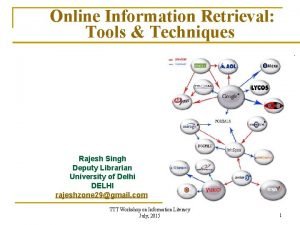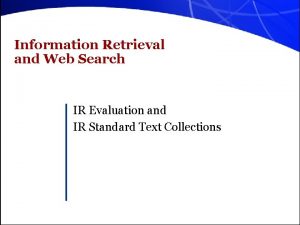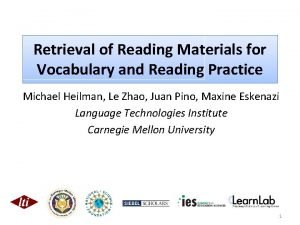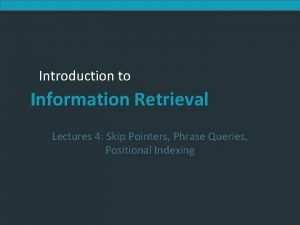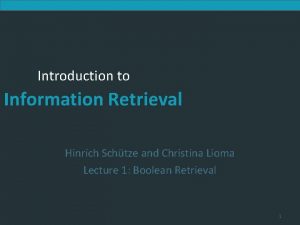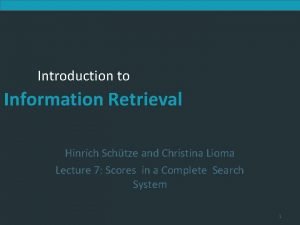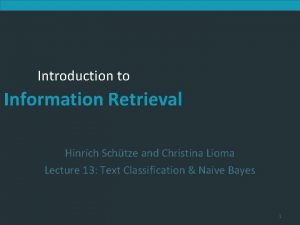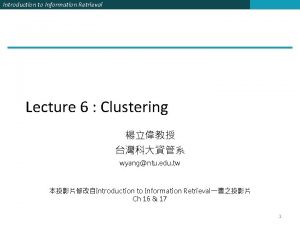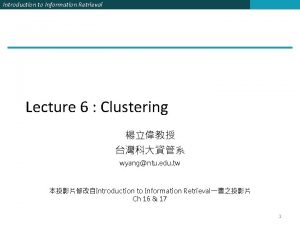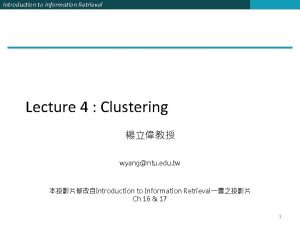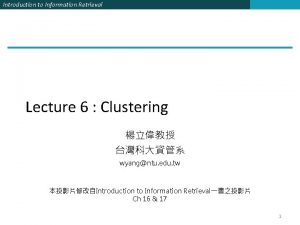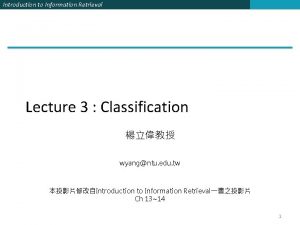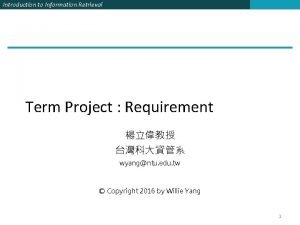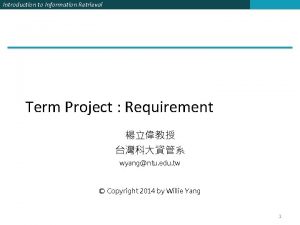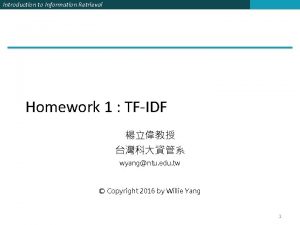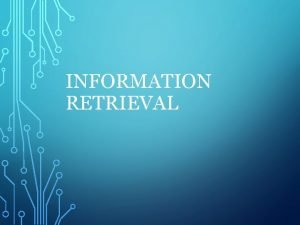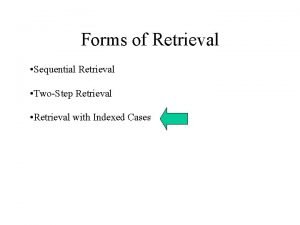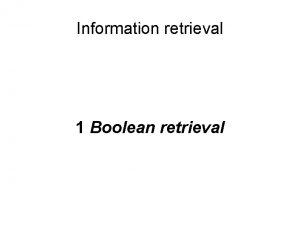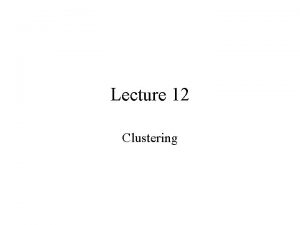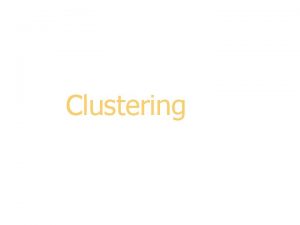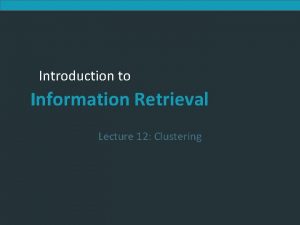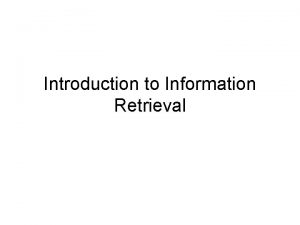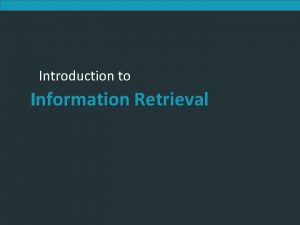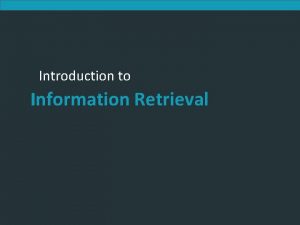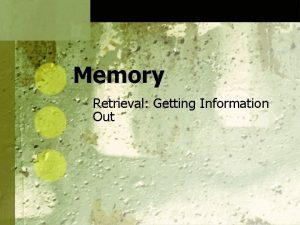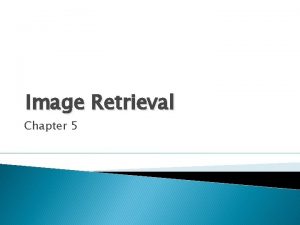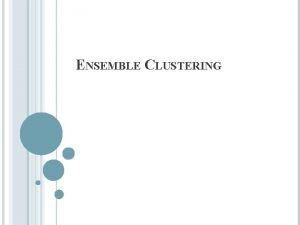Introduction to Information Retrieval Lecture 4 Clustering wyangntu













































































- Slides: 77

Introduction to Information Retrieval Lecture 4 : Clustering 楊立偉教授 wyang@ntu. edu. tw 本投影片修改自Introduction to Information Retrieval一書之投影片 Ch 16 & 17 1

Introduction to Information Retrieval Clustering : Introduction 2

Introduction to Information Retrieval Clustering: Definition § (Document) clustering is the process of grouping a set of documents into clusters of similar documents. § Documents within a cluster should be similar. 群內盡量相似 § Documents from different clusters should be dissimilar. 群間盡量相異 § Clustering is the most common form of unsupervised learning. § Unsupervised = there are no labeled or annotated data. 3

Introduction to Information Retrieval Data set with clear cluster structure Propose algorithm for finding the cluster structure in this example 4

Introduction to Information Retrieval Classification vs. Clustering § Classification § Supervised learning § Classes are human-defined and part of the input to the learning algorithm. § Clustering § Unsupervised learning § Clusters are inferred from the data without human input. 5

Introduction to Information Retrieval Why cluster documents? • Whole corpus analysis/navigation – Better user interface 提供文件(資料)集合的分析與導覽 • For improving recall in search applications – Better search results 提供完整的搜尋結果(相似的也找出 ) • For better navigation of search results – Effective "user recall" will be higher 搜尋結果導覽 • For speeding up vector space retrieval – Faster search 加快搜尋速度(因為限縮了範圍) 6

Introduction to Information Retrieval For visualizing a document collection • Wise et al, "Visualizing the non-visual" PNNL • Theme. Scapes, Cartia – [Mountain height = cluster size] 7

Introduction to Information Retrieval For improving search recall • Cluster hypothesis - "closely associated documents tend to be relevant to the same requests". • Therefore, to improve search recall: – Cluster docs in corpus 先將文件做分群 – When a query matches a doc D, also return other docs in the cluster containing D 也建議符合的整群 • Hope if we do this: The query "car" will also return docs containing automobile – Because clustering grouped together docs containing car with those containing automobile. Why might this happen? 具有類似的文件特徵 8

Introduction to Information Retrieval For better navigation of search results • For grouping search results thematically – clusty. com / Vivisimo (Enterprise Search – Velocity) 9

Introduction to Information Retrieval 10

Introduction to Information Retrieval 11


Introduction to Information Retrieval Issues for clustering (1) • General goal: put related docs in the same cluster, put unrelated docs in different clusters. • Representation for clustering – Document representation 如何表示一篇文件 – Need a notion of similarity/distance 如何表示相似度 13

Introduction to Information Retrieval Issues for clustering (2) • How to decide the number of clusters – Fixed a priori : assume the number of clusters K is given. – Data driven : semiautomatic methods for determining K – Avoid very small and very large clusters • Define clusters that are easy to explain to the user 14

Introduction to Information Retrieval Clustering Algorithms • Flat (Partitional) algorithms 無階層的聚類演算法 – Usually start with a random (partial) partitioning – Refine it iteratively 不斷地修正調整 • K means clustering • Hierarchical algorithms 有階層的聚類演算法 – Create a hierarchy – Bottom-up, agglomerative 由下往上聚合 – Top-down, divisive 由上往下分裂 15

Introduction to Information Retrieval Flat (Partitioning) Algorithms • Partitioning method: Construct a partition of n documents into a set of K clusters 將 n 篇文件分到 K 群中 • Given: a set of documents and the number K • Find: a partition of K clusters that optimizes the chosen partitioning criterion – Globally optimal: exhaustively enumerate all partitions 找出最佳切割 → 通常很耗時 – Effective heuristic methods: K-means and K-medoids algorithms 用經驗法則找出近似解即可 16

Introduction to Information Retrieval Hard vs. Soft clustering § Hard clustering: Each document belongs to exactly one cluster. § More common and easier to do § Soft clustering: A document can belong to more than one cluster. § For applications like creating browsable hierarchies § Ex. Put sneakers in two clusters: sports apparel, shoes § You can only do that with a soft clustering approach. *only hard clustering is discussed in this class. 17

Introduction to Information Retrieval K-means algorithm 18

Introduction to Information Retrieval K-means § Perhaps the best known clustering algorithm § Simple, works well in many cases § Use as default / baseline for clustering documents 19

Introduction to Information Retrieval K-means • In vector space model, Assumes documents are real-valued vectors. • Clusters based on centroids (aka the center of gravity 重心 or mean) of points in a cluster, c: • Reassignment of instances to clusters is based on distance to the current cluster centroids. 20

Introduction to Information Retrieval K-means algorithm 1. Select K random docs {s 1, s 2, … s. K} as seeds. 先挑選種子 2. Until clustering converges or other stopping criterion: 重複下列步驟直到收斂或其它停止條件成立 2. 1 For each doc di: 針對每一篇文件 Assign di to the cluster cj such that dist(xi, sj) is minimal. 將該文件加入最近的一群 2. 2 For each cluster cj sj = (cj) 以各群的重心為種子,再做一次 (Update the seeds to the centroid of each cluster) 21

Introduction to Information Retrieval K-means algorithm 22

Introduction to Information Retrieval K-means example (K=2) Pick seeds Reassign clusters Compute centroids x x Reassign clusters Compute centroids Reassign clusters Converged! 通常做 3至 4回就大致穩定(但仍需視資料與群集多寡而調整) 23

Introduction to Information Retrieval Termination conditions • Several possibilities, e. g. , – A fixed number of iterations. 只做固定幾回合 – Doc partition unchanged. 群集不再改變 – Centroid positions don’t change. 重心不再改變 24

Introduction to Information Retrieval Convergence of K-Means • Why should the K-means algorithm ever reach a fixed point? – A state in which clusters don’t change. 收斂 • K-means is a special case of a general procedure known as the Expectation Maximization (EM) algorithm. – EM is known to converge. – Number of iterations could be large. 在理論上一定會收斂,只是要做幾回合的問題 (逼近法,且一開始逼近得快,之後逼近變慢) 25

Introduction to Information Retrieval Convergence of K-Means : 證明 • Define goodness measure of cluster k as sum of squared distances from cluster centroid: – Gk = Σi (di – ck)2 (sum over all di in cluster k) – G = Σk G k 計算每一群中文件與中心的距離平方,然後加總 • Reassignment monotonically decreases G since each vector is assigned to the closest centroid. 每 回合的動作只會讓G越來越小 26

Introduction to Information Retrieval Time Complexity • Computing distance between two docs is O(m) where m is the dimensionality of the vectors. • Reassigning clusters: O(Kn) distance computations, or O(Knm). • Computing centroids: Each doc gets added once to some centroid: O(nm). • Assume these two steps are each done once for I iterations: O(IKnm). 執行 I 回合;分 K 群;n 篇文件;m 個詞 → 慢且不scalable 改善方法:用 近似估計, 抽樣, 選擇 等技巧來加速 27

Introduction to Information Retrieval Issue (1) Seed Choice • Results can vary based on random seed selection. • Some seeds can result in poor convergence rate, or convergence to sub-optimal clusterings. – Select good seeds using a heuristic (e. g. , doc least similar to any existing mean) – Try out multiple starting points Example showing sensitivity to seeds In the above, if you start with B and E as centroids you converge to {A, B, C} and {D, E, F} If you start with D and F you converge to {A, B, D, E} {C, F} 28

Introduction to Information Retrieval Issue (2) How Many Clusters? • Number of clusters K is given – Partition n docs into predetermined number of clusters • Finding the “right” number of clusters is part of the problem 假設 連應該分成幾群都不知道 – Given docs, partition into an “appropriate” number of subsets. – E. g. , for query results - ideal value of K not known up front - though UI may impose limits. 查詢結果分群時通常不會預先知道該分幾群 29

Introduction to Information Retrieval If K not specified in advance • Suggest K automatically – using heuristics based on N • 依經驗法則,例如每m筆分1群,缺點是可能很不準 – using K vs. Cluster-size diagram 畫成圖表來分析 • Tradeoff between having less clusters (better focus within each cluster) and having too many clusters 如何取捨 30

Introduction to Information Retrieval • 方法: 以「群間變異對應 於整體變異的百分比」來 看 (即F檢驗),每增加一 群所能帶來的邊際變異開 始下降的前一點。 Ref: "Determining the number of clusters in a data set", Wikipedia. 31

Introduction to Information Retrieval • The Calinski-Harabasz index – 群內方差和WGSS : 加總各群內各點離各群中心距離之平方和 – 群間方差和BGSS : 加總各群中心與全資料中心距離之平方和 – BGSS越大越好,WGSS越小越好,因此得到的分數越高越好。 Ref: "Clustering Indices", cluster. Crit package, R project. 32

Introduction to Information Retrieval K-means variations • Recomputing the centroid after every assignment (rather than after all points are re-assigned) can improve speed of convergence of K-means 每個點調整後就重算重心,可以加快收斂 33

Introduction to Information Retrieval Evaluation of Clustering 34

Introduction to Information Retrieval What Is A Good Clustering? • Internal criterion: A good clustering will produce high quality clusters in which: – the intra-class (that is, intra-cluster) similarity is high 群內同質性越高越好 – the inter-class similarity is low 群間差異大 • The measured quality of a clustering depends on both the document representation and the similarity measure used 35

Introduction to Information Retrieval External criteria for clustering quality • Based on a gold standard data set (ground truth) – e. g. , the Reuters collection we also used for the evaluation of classification • Goal: Clustering should reproduce the classes in the gold standard • Quality measured by its ability to discover some or all of the hidden patterns 用挑出中間不符合的份子來評估分群好不好 36

Introduction to Information Retrieval External criterion: Purity § Ω= {ω1, ω2, . . . , ωK} is the set of clusters and C = {c 1, c 2, . . . , c. J} is the set of classes. § For each cluster ωk : find class cj with most members nkj in ωk § Sum all nkj and divide by total number of points purity是群中最多一類佔該群總數之比例 37

Introduction to Information Retrieval Example for computing purity To compute purity: 5 = maxj |ω1 ∩ cj | (class x, cluster 1) 4 = maxj |ω2 ∩ cj | (class o, cluster 2) 3 = maxj |ω3 ∩ cj | (class ⋄, cluster 3) Purity is (1/17) × (5 + 4 + 3) ≈ 0. 71. 38

Introduction to Information Retrieval Rand Index Number of points Same Cluster in clustering 分在同一群 Different Clusters in clustering 分在不同群 Same class in ground truth 已知同一類 A C Different classes in ground truth 已知不同類 B D 39

Introduction to Information Retrieval Rand index: symmetric version Compare with standard Precision and Recall. 40

Introduction to Information Retrieval Rand Index example: 0. 68 Number of points Same Cluster in clustering Different Clusters in clustering Same class in ground truth 20 24 Different classes in ground truth 20 72 41

Introduction to Information Retrieval DBSCAN algorithm 42

Introduction to Information Retrieval DBSCAN § Density-based clustering : clusters are dense regions in the data space, separated by regions of lower object density. A cluster is defined as a maximal set of density -connected points § May discovers clusters of arbitrary shape § c. f. K-mean is spherical Ref: Density-Based Spatial Clustering of Applications with Noise 43

Introduction to Information Retrieval DBSCAN § Definition § Eps-neighborhood of point p : points within radius eps from p § "High density" : Eps-neighborhood of a point contains at least Min. Pts of points For radius ɛ, Min. Pts=4. Density of p is "high" Density of q is "low" 44

Introduction to Information Retrieval DBSCAN § Core points, Border points, and Noise points § A point is a core point if it has more than a specified number of points (Min. Pts) within Eps—These are points that are at the interior of a cluster § A border point has fewer than Min. Pts within Eps, but is in the neighborhood of a core point § A noise point is any point that is not a core point nor a border point. 45

Introduction to Information Retrieval Example See http: //www. cse. buffalo. edu/~jing/cse 601/fa 12/materials/clustering_density. pdf 46

Introduction to Information Retrieval DBSCAN § Directly density-reachable § point q is directly density-reachable from point p if p is a core object and q is in eps-neighborhood of p q is directly density-reachable from p p is not directly density-reachable from q Min. Pts=4 density-reachability is asymmetric 47

Introduction to Information Retrieval 48

Introduction to Information Retrieval 49

Introduction to Information Retrieval 50

Introduction to Information Retrieval 51

Introduction to Information Retrieval 52

Introduction to Information Retrieval Visualize the algorithm http: //www. naftaliharris. com/blog/visualizing-dbscan-clustering/ 53

Introduction to Information Retrieval After clustering. 54

Introduction to Information Retrieval Hierarchical Clustering 55

Introduction to Information Retrieval Hierarchical Clustering • Build a tree-based hierarchical taxonomy (dendrogram) from a set of documents. animal vertebrate fish reptile amphib. mammal invertebrate worm insect crustacean • One approach: recursive application of a partitional clustering algorithm. 可由每一層不斷執行分群演算法所組成 56

Introduction to Information Retrieval Dendrogram: Hierarchical Clustering • Clustering obtained by cutting the dendrogram at a desired level: each connected component forms a cluster. 另一種思考: 對階層樹橫向切一刀, 留下有連接在一起的, 就構成一群 57

Introduction to Information Retrieval Hierarchical Clustering algorithms • Agglomerative (bottom-up): 由下往上聚合 – Start with each document being a single cluster. – Eventually all documents belong to the same cluster. • Divisive (top-down): 由上往下分裂 – Start with all documents belong to the same cluster. – Eventually each node forms a cluster on its own. • Does not require the number of clusters k in advance – 不需要先決定要分成幾群 • Needs a termination condition 58

Introduction to Information Retrieval Hierarchical Agglomerative Clustering (HAC) Algorithm • Starts with each doc in a separate cluster 每篇文件剛開始都自成一群 – then repeatedly joins the closest pair of clusters, until there is only one cluster. 不斷地將最近的二群做連接 • The history of merging forms a binary tree or hierarchy. 連接的過程就構成一個二元階層樹 59

Introduction to Information Retrieval Dendrogram: Document Example • As clusters agglomerate, docs likely to fall into a hierarchy of “topics” or concepts. d 3 d 5 d 1 d 2 d 3, d 4, d 5 d 4 d 1, d 2 d 4, d 5 d 3 60

Introduction to Information Retrieval Closest pair of clusters 如何計算最近的二群 • Many variants to defining closest pair of clusters • Single-link 挑群中最近的一點來代表 – Similarity of the most cosine-similar (single-link) • Complete-link 挑群中最遠的一點來代表 – Similarity of the “furthest” points, the least cosine-similar • Centroid 挑群中的重心來代表 – Clusters whose centroids (centers of gravity) are the most cosine-similar • Average-link 跟群中的所有點計算距離後取平均值 – Average cosine between pairs of elements 61

Introduction to Information Retrieval Single Link Agglomerative Clustering • Use maximum similarity of pairs: • Can result in “straggly” (long and thin) clusters due to chaining effect. 長而鬆散的群集 • After merging ci and cj, the similarity of the resulting cluster to another cluster, ck, is: 62

Introduction to Information Retrieval Single Link Example 63

Introduction to Information Retrieval Complete Link Agglomerative Clustering • Use minimum similarity of pairs: • Makes “tighter, ” spherical clusters that are typically preferable. 緊密一點的群集 • After merging ci and cj, the similarity of the resulting cluster to another cluster, ck, is: Ci Cj Ck 64

Introduction to Information Retrieval Complete Link Example 65

Introduction to Information Retrieval Computational Complexity • In the first iteration, all HAC methods need to compute similarity of all pairs of n individual instances which is O(n 2). 兩兩文件計算相似性 • In each of the subsequent n 2 merging iterations, compute the distance between the most recently created cluster and all other existing clusters. – 包含合併過程 O(n 2 log n) 66

Introduction to Information Retrieval Key notion: cluster representative • We want a notion of a representative point in a cluster 如何代表該群→可以用中心或其它點代表 • Representative should be some sort of “typical” or central point in the cluster, e. g. , 67

Introduction to Information Retrieval Example: n=6, k=3, closest pair of centroids d 6 d 4 d 3 d 5 Centroid after second step. d 1 d 2 Centroid after first step. 68

Introduction to Information Retrieval Outliers in centroid computation • Can ignore outliers when computing centroid. • What is an outlier? – Lots of statistical definitions, e. g. – moment of point to centroid > M some cluster moment. Say 10. Centroid Outlier 簡單說就是距離太遠的點 (ex. 10倍遠),直接忽略 69

Introduction to Information Retrieval Using Medoid As Cluster Representative • The centroid does not have to be a document. • Medoid: A cluster representative that is one of the documents 用以代表該群的某一份文件 – Ex. the document closest to the centroid • Why use Medoid ? – Consider the representative of a large cluster (>1000 documents) – The centroid of this cluster will be a dense vector – The medoid of this cluster will be a sparse vector 70

Introduction to Information Retrieval Clustering : discussion 71

Introduction to Information Retrieval Feature selection 選擇好的詞再來做分群 • Which terms to use as axes for vector space? – IDF is a form of feature selection – the most discriminating terms 鑑別力好的詞 • Ex. use only nouns/noun phrases 72

Introduction to Information Retrieval Labeling 在分好的群上加標記 • After clustering algorithm finds clusters - how can they be useful to the end user? • Need pithy label for each cluster 加上簡潔厄要的標記 – In search results, say “Animal” or “Car” in the jaguar example. – In topic trees (Yahoo), need navigational cues. • Often done by hand, a posteriori. 事後以人 編輯 73

Introduction to Information Retrieval How to Label Clusters • Show titles of typical documents 用幾份代表文件的標題做標記 • Show words/phrases prominent in cluster 用幾個較具代表性的詞做標記 – More likely to fully represent cluster – Use distinguishing words/phrases 配合自動產生關鍵詞的技術 74

Introduction to Information Retrieval Labeling • Common heuristics - list 5 -10 most frequent terms in the centroid vector. 通常用 5~10個詞來代表該群 • Differential labeling by frequent terms – Within a collection “Computers”, clusters all have the word computer as frequent term. – Discriminant analysis of centroids. – 要挑選有鑑別力的詞 75


Introduction to Information Retrieval • Topic Modelling (with LSA, p. LSA, or LDA) brain computer data dna evolve genetic life organism nerve neuron number … Clustering words into topics 77
 Flat cluster
Flat cluster Divisive hierarchical clustering example
Divisive hierarchical clustering example Rumus euclidean distance
Rumus euclidean distance Introduction to information retrieval
Introduction to information retrieval Bvf document
Bvf document Introduction to information retrieval
Introduction to information retrieval Manning information retrieval
Manning information retrieval 01:640:244 lecture notes - lecture 15: plat, idah, farad
01:640:244 lecture notes - lecture 15: plat, idah, farad Sequential searching
Sequential searching Search engine architecture
Search engine architecture Recall and precision in information retrieval
Recall and precision in information retrieval Modern information retrieval
Modern information retrieval Query operations in information retrieval
Query operations in information retrieval Positional index information retrieval
Positional index information retrieval Index construction in information retrieval
Index construction in information retrieval Index construction in information retrieval
Index construction in information retrieval Which internet service is used for information retrieval
Which internet service is used for information retrieval Information retrieval tutorial
Information retrieval tutorial Wildcard query in information retrieval
Wildcard query in information retrieval Browse capabilities in information retrieval system
Browse capabilities in information retrieval system Link analysis in information retrieval
Link analysis in information retrieval Information retrieval lmu
Information retrieval lmu Defense acquisition management information retrieval
Defense acquisition management information retrieval Advantages of information retrieval system
Advantages of information retrieval system Information retrieval nlp
Information retrieval nlp Signature file structure in information retrieval system
Signature file structure in information retrieval system Information retrieval slides
Information retrieval slides Relevance information retrieval
Relevance information retrieval Stanford information retrieval
Stanford information retrieval Link analysis in information retrieval
Link analysis in information retrieval Skip pointers in information retrieval
Skip pointers in information retrieval Anthony julius
Anthony julius Levenshtein distance for oslo-snow
Levenshtein distance for oslo-snow Information retrieval
Information retrieval Information retrieval
Information retrieval Relevance information retrieval
Relevance information retrieval Information retrieval
Information retrieval Information retrieval
Information retrieval Information retrieval
Information retrieval Information retrieval
Information retrieval Cs-276
Cs-276 Cs 276
Cs 276 Information retrieval
Information retrieval Information retrieval
Information retrieval Information retrieval
Information retrieval Cs 276
Cs 276 Information retrieval
Information retrieval Information retrieval
Information retrieval Cs 276
Cs 276 Cs 276
Cs 276 Information retrieval
Information retrieval Information retrieval
Information retrieval Tokenization in information retrieval
Tokenization in information retrieval Link analysis in information retrieval
Link analysis in information retrieval Information retrieval and web search
Information retrieval and web search Map information retrieval
Map information retrieval Information retrieval data structures and algorithms
Information retrieval data structures and algorithms Probabilistic model information retrieval
Probabilistic model information retrieval A formal study of information retrieval heuristics
A formal study of information retrieval heuristics Relevance information retrieval
Relevance information retrieval Information retrieval textbook
Information retrieval textbook Statistical language models for information retrieval
Statistical language models for information retrieval Search engines information retrieval in practice
Search engines information retrieval in practice Dr paul ogilvie
Dr paul ogilvie Index compression in information retrieval
Index compression in information retrieval Elasticsearch information retrieval
Elasticsearch information retrieval Semantic information retrieval
Semantic information retrieval Relevance feedback example
Relevance feedback example Examples of information retrieval tools
Examples of information retrieval tools Information retrieval evaluation
Information retrieval evaluation Info 430
Info 430 Modern information retrieval
Modern information retrieval Dipti vaidya
Dipti vaidya Information retrieval tutor
Information retrieval tutor Skip pointers
Skip pointers Boolean model information retrieval example
Boolean model information retrieval example Information retrieval
Information retrieval Information retrieval
Information retrieval



